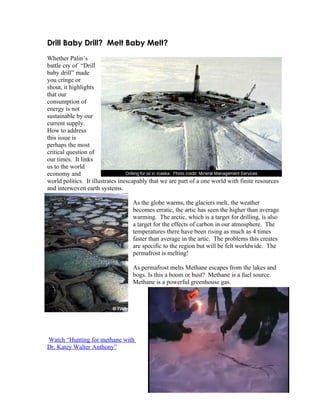
Permafrost pbl
- 1. Drill Baby Drill? Melt Baby Melt? Whether Palin’s battle cry of “Drill baby drill” made you cringe or shout, it highlights that our consumption of energy is not sustainable by our current supply. How to address this issue is perhaps the most critical question of our times. It links us to the world economy and world politics. It illustrates inescapably that we are part of a one world with finite resources and interwoven earth systems. As the globe warms, the glaciers melt, the weather becomes erratic, the artic has seen the higher than average warming. The arctic, which is a target for drilling, is also a target for the effects of carbon in our atmosphere. The temperatures there have been rising as much as 4 times faster than average in the artic. The problems this creates are specific to the region but will be felt worldwide. The permafrost is melting! As permafrost melts Methane escapes from the lakes and bogs. Is this a boom or bust? Methane is a fuel source. Methane is a powerful greenhouse gas. Watch “Hunting for methane with Dr. Katey Walter Anthony”
- 2. All this Methane could be a boon for energy companies. Is there a way to capture the methane that is being produced? Methane gas is a powerful greenhouse gas. If we burn it and release carbon dioxide is that a step in the right direction? What are the local and global effects of this permafrost melting?!? Your goal through analysis, research and collaboration is to create a report about the local and global phenomenon of Permafrost melt to give to congress. Where is there permafrost melting? And in what kind of biome? What are the case and effects? How might it effect power companies? Is this a good source of Methane? Is the biome where harvesting or drilling happening put at further risk by permafrost melt? Here are the 6 steps to follow: Read the entire description of the project including the rubric before beginning One: Brainstorm. Using the event of Permafrost melt, every person should first write an ESSA including all the event to sphere connections, sphere to event, sphere to sphere connections, and causal chains. As you go, create a list of things you need to know or questions that you have. Two: Collaborate by brainstorming with your teammates. Do this by sharing your lists with each other. Choose a note-taker and a question-writer. Give a written version of your brainstorm to the note-taker and keep one for yourself. Share you understanding through discussion. How does your ESS analysis compare to others? Try to answer others questions as a group. As you go have the question-writer keep a list of questions the group needs to research. (Hand a copy of this in.) Three: Research by dividing up the research questions between teammates. Research by using the resources given in this document or from trusted sites. Answer the questions as fully as you can. Site your information as you go. Put your significant sites on delicious for your team members to use Four: Collaborate more by sharing your research and deciding what points and information need to be included in your Presentation. Create a list of questions that the group still has that may be extension questions. Reevaluate your group list of connections and chains. Add our new understanding. Five: Create a Presentation that describes your scientific understanding of permafrost melt, and the effects of interconnectedness of the ES systems. Include what you have learned about atmospheric gases and the greenhouse effect, deposited of methane and the land where it resides. Include the significance of permafrost melt on human structures and liveliness. Make sure that you use images, charts and /or graphs to help your explanation and hold interest. Also, create a bulleted list of the important information you are including. Share this list with your instructor and the other groups to get feedback to prepare yourselves for the presentation. Give feedback to other groups on their lists. Revise your Presentaion if needed.
- 3. Six: Present it to “Congress” (This may include parents, school staff and students.) Ask your Audience for feedback. Do they understand your list of important points or issues? Do they understand that this is a global problem with global solutions? What are some of the action steps they think their governments might take to contribute to the solution of this problem? Resources: “Source characterization and temporal variation of methane seepage from thermokarst lakes on the Alaska North Slope in response to Arctic climate change” is the stated purpose of the project at this site. Predicted changes in thickness of active layer (the soil above permafrost that melts each year in the summer sun) by 2050 (from Anisimov et al., 1997) under some global warming scenarios. The Alaskan North Slope is expected to experience some of the most profound changes in permafrost conditions http://www.netl.doe.gov/technologies/oil- gas/FutureSupply/MethaneHydrates/projects/DOEProjects/MH_5665ThermokarstLakes.ht ml Methane (CH4) is formed and released into the atmosphere by biologic processes. Methane is a greenhouse gas that will absorbs infrared radiation causing an increase in global temperatures. http://www.epa.gov/methane/scientific.html Locally, there are feedback mechanisms that show that melt yields increased melt. Related specifically to methane release, the release of the gas thins the winter ice above a seep area on a thermokarst lake. E> G> H http://www.gi.alaska.edu/snowice/Permafrost-lab/projects/ projects_active/proj_thermokarst_NASA.html How Does Climate Change Influence Alaska's Vegetation?: Insights from the Fossil Record “Plant fossils, such as leaves, wood, cones, pollen, and seeds, provide important evidence of how Alaska's vegetation has responded to climate changes over time periods of centuries to millions of years. Long-term trends of global temperatures have been reconstructed…” http://pubs.usgs.gov/fs/fs-0071-97/ U.S. Arctic Research Commission Permafrost Task Force (2003) Climate Change, Permafrost, and Impacts on Civil Infrastructure. Special Report 01-03, U.S. Arctic Research Commission, Arlington, Virginia www.arctic.gov/publications/permafrost.pdf
- 4. Global Terrestrial Observing system report link on Permafrost and seasonally-frozen ground page report. The link for the report, documentation and other material have been compiled for permafrost. www.arctic.gov/publications/permafrost.pdf